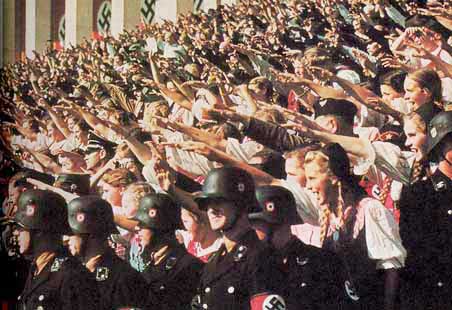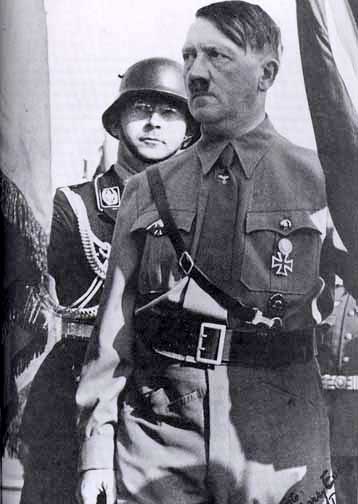Nazi Party rallies at the Zeppelin
Field
 Nazi party rally in
city of Nürnberg in 1927
YouTube video shows footage
of 1927 rally in Nürnberg
Nazi party rally in
city of Nürnberg in 1927
YouTube video shows footage
of 1927 rally in Nürnberg
Although many travel guidebooks say that
the Zeppelin field was first used in 1927 for a Nazi party rally,
the picture above clearly shows that it was held in the city
of Nürnberg that year. In this photo, taken during the August
19-20, 1927 rally, Georg Halberman and Pfeffer von Salomon stand
in the front, wearing Bavarian lederhosen (leather shorts) and
knee socks as part of their uniform while Hitler and his right-hand
man, Rudolph Hess, who is smiling in the background, salute the
parade of Sturmabteilung (SA) troops from the back seat of a
convertible.
Hess was Hitler's strongest supporter
and his personal secretary until 1941 when Hess took his life
in his hands to pilot a plane to Scotland, some say at the behest
of Hitler, in an attempt to negotiate with the British for peace
and an end to World War II. Hess was imprisoned by the British
until the end of the war; then he was tried and convicted by
the Nuremberg International Military Tribunal on charges of participating
in a "common design" to commit Crimes against Peace.
As Hitler's secretary, Hess had signed some of the orders given
by Hitler, which made him a war criminal. Hess allegedly committed
suicide at the age of 93 in Spandau prison after serving a life
sentence.
 Nazi SS troopers hold
back crowd at 1938 rally
Nazi SS troopers hold
back crowd at 1938 rally
One of the obsessions of the Nazis was
the desire to return to the past and to bring back the ancient
German culture. The medieval city of Nürnberg, with its
castle dating back to the reign of Kaiser Frederick Barbarossa,
was a favorite of Adolf Hitler because it is rich in German history.
It was because of the historical significance of Nürnberg
that Hitler selected the city as the site of the annual Nazi
Parteitage (Party Day). The first official party rally was held
in 1927 in the city itself with speeches given at the Hauptmarkt,
the main town square. Before 1927, there had been rallies in
Nürnberg on German Day which Hitler and other party members
attended.
Every Nazi party rally began with a performance
of "Die Meistersinger von Nürnberg," an opera
by Richard Wagner, which was Hitler's favorite. The cult of the
Nazis had its origins in the music of Wagner which glorified
the German past. To this day, the music of Wagner is banned in
Israel because it is a reminder of Hitler.
In 1933, an airfield called the Zeppelin
Field, outside the city center, was first used for the party
rally because it offered a huge space for party members to gather
and listen to the nationalistic ranting of their leader.
According to Albert Speer, Hitler's architect,
in his Memoirs entitled "Inside the Third Reich," the
first Party Rally to be held at the Zeppelin field was in 1933
after Hitler was appointed Chancellor of the Reich. As Hitler's
official architect, Speer was commissioned to design a temporary
reviewing stand at the Zeppelin Field. He designed a gigantic
eagle with a wingspread of over 100 feet. "I spiked it to
a timber framework like a butterfly in a collection," Speer
wrote.
 Eagle designed by Albert
Speer for 1933 rally
Eagle designed by Albert
Speer for 1933 rally
The photo above shows the eagle behind
the temporary reviewing stand which was replaced in 1934 by the
marble structure that still stands today.
The Nazi party rallies in Nürnberg
were designed to impress the rest of the world with Germany's
military might and the party's solid support of Hitler. To people
who were alive before World War II started, the name Nürnberg
immediately evokes images of the spectacular Nazi rallies. The
speeches were broadcast around the world by radio, and films
of the event were shown in the newsreels that preceded movies
in theaters, the 1930ies substitute for television world news.
In 1935, Hitler commissioned the beautiful and talented movie
actress, Leni Riefenstahl, to produce the film "Triumph
des Willens (Triumph of the Will), which is still frequently
shown on the History Channel on cable television; it is a propaganda
documentary of the 1935 annual party rally at the Zeppelin Field.
In 1934, Albert Speer was commissioned
to design a permanent stone structure for the party rallies at
the Zeppelin Field. According to Speer, his design was "a
mighty flight of stairs topped and enclosed by a long colonnade,
flanked on both ends by stone abutments. Undoubtedly it was influenced
by the Pergamum altar." He added that "The structure
had a length of thirteen hundred feet and a height of eighty
feet. It was almost twice the length of the Baths of Caracalla
in Rome."
Speer wrote that he designed the Tribüne
at the Zeppelin Field so that it would still look beautiful even
"after generations of neglect, overgrown with ivy, its columns
fallen, the walls crumbling here and there, but the outlines
still clearly recognizable." Speer was tried by the International
Military Tribunal in Nuremberg in 1945; he was convicted and
served 20 years in Spandau prison for his part in the "common
plan" of the Nazis to commit war crimes. Speer was the man
in charge of the forced labor camps in Germany during the war.
In a footnote in his book, Speer mentioned that the Palace of
Justice was repaired in preparation for the IMT by the forced
labor of the defeated Germans.
In 1938, Germany annexed Austria and the Sudetenland (part of Czechoslovakia) into Grossdeutschland (Greater Germany). As a result, membership in the Hitler Youth increased to 8.7 million boys. At many of the Nuremberg rallies, the Hitler Youth was prominently represented.
In September 1938, the last peacetime rally took place at Nuremberg. This was the largest Nazi rally ever held; there were around 700,000 members of various Nazi organizations which took part in the festivities which lasted for a week.
On Saturday, September 10, 1938, over 800,000 members of the Hitler Youth marched into the Nuremberg stadium and performed military style maneuvers which they had been practicing for a whole year. In the grand finale, they spelled out the name Adolf Hitler. Hitler gave a speech in which he said, "You, my youth, are our nation's most precious guarantee for a great future, and you are destined to be the leaders of a glorious new order under the supremacy of National Socialism. Never forget that one day you will rule the world."
Hitler was an amateur architect who had
many grandiose plans for classic buildings that would leave a
lasting legacy for his "Thousand Year Reich." Many
of the major Nazi concentration camps were located near quarries,
brick factories or gravel pits to provide building materials
for proposed new buildings designed by Speer and Hitler himself.
The Natzweiler-Struthof
camp in Alsace was originally opened because it had a quarry
with red granite, suitable for new buildings in Nürnberg.
Heinrich Himmler
was the second in command in the Nazi party and the man behind
Hitler, literally and figuratively as the photograph below shows.
It was taken on the reviewing stand at the 1938 Party Rally at
Nürnberg. Himmler was the man responsible for all the concentration
camps and for carrying out Hitler's systematic plan to exterminate
the Jews. He was captured by the British soon after the war,
but allegedly committed suicide before he could be put on trial.
Hitler also escaped Justice at Nuremberg when he committed suicide
on April 30, 1945 just before the surrender of Germany to the
Allies on May 7, 1945.
The medal pinned to Hitler's uniform
is the diamond-encrusted Iron Cross, First Class, Germany's highest
medal for military bravery, which was awarded to him when he
was a soldier in World War I. Himmler is wearing the black uniform
of the SS; he was born in 1900 and just missed serving his country
in World War I.

Heinrich Himmler behind
Hitler at 1938 Party rally
This page was last updated on June 6, 2012
|